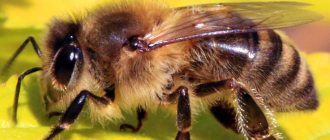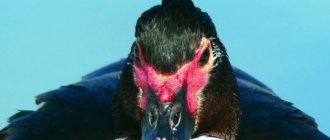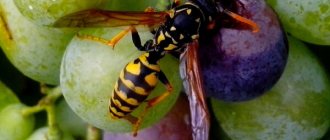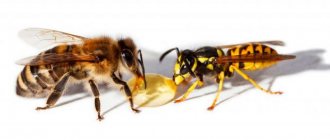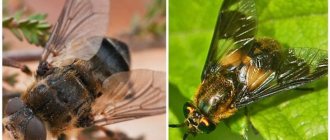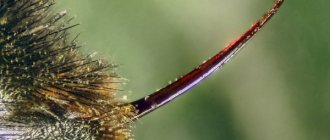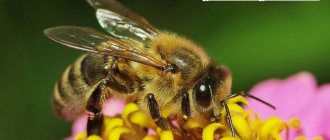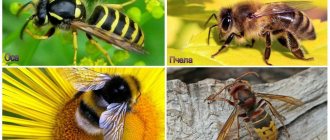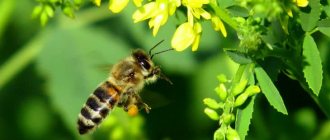The insect photo clearly demonstrates the differences between a bee and a wasp; city residents need to carefully study them before going out into nature. Both insects sting painfully, and their bites can cause allergic reactions. It is worth knowing their habits, the places where they can be found most often, in order to protect yourself and your children from attack. In addition, both species differ in varying degrees of aggressiveness.
With the onset of warm weather, almost all insects become active. Wasps and bees do not stand aside, reminding us of their existence in the natural environment, on the balconies of apartments, in city parks and squares, on personal plots. From the school curriculum, few people remember the difference between a wasp and a bee. Interest is sharply awakened at the sight of stinging insects and especially after their bites.
By appearance
According to the classification, they belong to different orders - they differ so much in description and behavior. Bees are easily recognizable by their furry bodies. It is round and massive. The yellow-black stripes on the body are not bright in color, but muted.
Wasps are a special mixture of insects that have borrowed heavily from bees and ants. Their body is long, narrow, and has a characteristic “waist” near the chest. At the same time, the body is absolutely smooth, devoid of villi. And the colors are very combative: the black and yellow stripes are bright and clearly defined.
The wasp is a rather aggressive insect. Its characteristic features are importunity and the ability to sting at any moment. In this case, the wasp does not die.
Nests
A family of real bees, in the absence of ready-made artificial hives and bumblebees, finds a suitable cavity and begins to build honeycombs there. Their nests do not have a specific shape, as they depend on the cavity in which the queen has settled.
The most common and familiar to us, real wasps, at the sight of which people are not mistaken about the identity of the insect, build nests on their own. In Russia, there can be two types: a vertically elongated top (the kind they depict in cartoons) and a curved “plate” of irregular shape. The “plate” resembles a sunflower core from which the seeds have been removed.
Wasps build their nests from chewed cellulose glued together with saliva. The structure of the nest material is very similar to thick paper.
Life activity
Bees are hard workers by nature. They are ready to work endlessly for the good of the hive. By collecting nectar from flowers, bees produce many useful products that are used in pharmaceuticals and human nutrition. Bees build honeycombs from the wax they produce.
Wasps are not capable of producing any useful product; they make their hives from a variety of waste.
The food of wasps is quite varied. They will not disdain either fruits or nectar. The diet of wasps also includes delicacies, which include flies and other small insects.
Nutritional Features
The bee is a true vegetarian and collects only nectar and pollen from flowers. Her nutritional principles are shared by bumblebee, a fellow connoisseur of flower products.
But wasps and hornets are avid hunters and predators. The protein menu is necessary for the larvae, so the workers attack small insects, sometimes even larger than them. Often their prey is a bee or a fly. To immobilize the victim, wasps do not always use their main weapon - the sting.
They successfully cope with weak opponents with the help of powerful jaws. Each species has its own strategy and tactics of attack, but in most cases they drag their prey into the nest, riding it on horseback.
Wasps clinging to a piece of meat, fish, or a fallen animal are a common occurrence. With their powerful jaws, they bite off tiny pieces of meat and bring them to the larvae in a chewed state.
With great enthusiasm, wasps and hornets eat fermented or fresh fruits, sugar-containing foods, sweet drinks and even beer.
Color
You can identify the difference between a bee and a wasp visually by their appearance. The color of the bee is muted yellow with black stripes. The body is covered with hairs.
The wasp is distinguished by a smooth body without signs of hair, rich yellow and contrasting black stripes. The bright “robe” of the insect is noticeable from a great distance. But the wasp does not need thick hair, because collecting nectar is not its main business.
If they suddenly disappear
Ecologists around the world are sounding the alarm, pointing to a decline in the number of bee and bumblebee families. If you imagine that wasps, bumblebees, and bees suddenly disappeared, then hardly anyone will notice the absence of the former. Their place will be taken by other lovers of insects and carrion. It doesn't make much difference who will destroy the pests. However, we should not forget that in addition to harm, wasps bring benefits, just like their relatives.
But humanity will immediately feel the disappearance of pollinators. Without bees, the pollinators of a significant part of fruit trees and shrubs, and bumblebees working on clover and in greenhouses, humanity will suffer famine. But scientists don’t yet know what to do about the decline in pollinator numbers.
Body structure
It is not for nothing that the wasp is famous for its wasp waist - the interception between the abdomen and chest. In the photo, the graceful curve is visible especially clearly. The body shape is elongated and elongated. Upon closer examination, powerful jaws and thin legs stand out.
The hornet is very similar in appearance to the wasp, but only with more developed jaws and a thicker waist.
On a note! The hornet is the largest insect among traditional wasps and bees; it is two to three times larger than them. The dimensions of the flyer can reach 5-6 cm.
The bee has a more rounded body and the interception between its parts is barely visible. Compared to the wasp, the proportions are harmonious. The abdomen differs in shape depending on what level the insect occupies in the bee hierarchy. In honey-bearing workers it is egg-shaped, in the queen it is elongated, and in drones it has a blunt ending. Unlike wasps, bees have so-called baskets on thick legs - containers in which they place flower nectar.
Differences in lifestyle and behavior
The flight path and the manner of controlling one’s own body are no less noticeable differences between a bee and a wasp. The honey collector flies smoothly. The wasp develops a decent speed, which is why its movements sometimes become jerky and it is capable of “hovering” in space for short periods of time.
Bumblebees have the calmest “driving style.” Because of their size and mass, they fly slowly, without rushing. Watching a flying bumblebee, one gets the impression that the poor fellow is trying to keep himself in the air with great effort.
Interesting! For a long time, naturalists generally considered the version that the flight qualities of bumblebees manifest themselves contrary to all the laws of aerodynamics.
It is common for all representatives to live in families:
- Domestic bees live in houses carefully prepared by beekeepers. Wild individuals create hives in tree hollows and rocky gorges. Occasionally there are bees that prefer a solitary lifestyle.
- Wasps can also live in organized families with a strict way of life, where everyone performs their own function, or they can be a hermit. Unlike bees, wasp nests look like paper, the material for their production is chewed grass and wood.
- Bumblebees live in small colonies, the number of which does not exceed 200 individuals. They build their nests in abandoned rodent burrows and tree hollows. They prefer to go alone to forage for food, while wasps most often move in groups.
- Hornets, as befits wasps, build paper nests. Only rotten stumps and branches act as building materials, so their home is brown in color, not gray.
How long does a bee live after being stung?
The lifespan of a bee after a sting depends on the damage it received. It happens that an insect will live only a few minutes. Sometimes 1.5-3 days. If bees attack insects that have a hard chitinous cover that is not elastic, the bee removes the sting and remains alive. Although a more detailed study of the life of both species and their differences casts doubt on the necessarily happy outcome of such an attack.
Sting
Both the bee and the wasp have a formidable weapon - a sting. After a bee stings, its sting, along with part of the intestine, remains in the human skin, as it has serrations, and the insect dies immediately. The wasp sting is smooth, and thanks to this feature the wasp can sting repeatedly. Besides, it not only stings. Powerful jaws allow it to bite through human skin, which is no less painful.
Otherwise, the consequences of bee and wasp stings are identical:
- the bite site swells and turns red;
- unbearable pain appears;
- health worsens;
- body temperature rises.
When to seek help from doctors
You should seek emergency medical help if:
- multiple bites;
- anaphylactic reactions occur;
- the victim is allergic;
- tongue, face or eye area bitten;
- a child or a pregnant woman is stung.
First aid rules
Everyone should know the rules of first aid for bites, because sometimes it can save someone’s life. So, what to do if a person is injured?
- Use tweezers to remove the sting from the wound.
- Wipe the bitten area with disinfectant liquid.
- Apply cold.
- Take an antiallergic drug.
- Provide plenty of fluids. This will allow you to quickly remove toxins from the body.
conclusions
- The bee has a more rounded body. The cover has villi, the color is muted. The wasp, on the contrary, has a smooth, elongated body and bright colors.
- Bees produce useful products: wax, honey, propolis. Wasps do not produce any useful products.
- Bees are not the first to attack, wasps are predators by nature, they are capable of stinging for no apparent reason.
- Once a bee stings, it dies. Wasps are capable of stinging repeatedly, and in addition they bite using the jaw apparatus.
- Bees feed exclusively on pollen, while wasps have a more varied diet.
Anatomy of insects
The anatomical structure of a bee consists of organs:
- digestion;
- breathing;
- lymphatic system;
- genital organs, which are located in the abdominal part.
The honey insect's abdomen is egg-shaped, the queen's is oblong, and the drone's has a blunt end. It consists of segments, which are a ring of 2 halves. Drones have 7 segments, the rest have 6. Between the last segments there is a stinging apparatus.
The digestive system of bees consists of 3 sections, and digestion occurs while food moves through the canal. The lymphatic system is not closed, filled with hemolymph and liquid matter. The organs of the system include the five-chambered heart and blood vessels.
The internal structure of a bee in cross-section looks like this: a number of glands, vessels, nodes, food organs. A feature of the structure of the respiratory organs is the presence of air sacs without a chitinous lining inside and a tracheal system with holes in the rings, which open depending on the state of the insect and the degree of its load.
The nervous system of a bee consists of the following parts:
- central;
- peripheral;
- vegetative.
The weight of a bee depends on the functional responsibilities in the family. For the honey bee it is 0.1 g, and for the queen bee - 0.25 g.
The oral apparatus consists of the upper and lower lips, paired upper and lower jaws. The bee's mouthparts are equipped with a proboscis, which the insect uses to collect nectar.
Insect sting
The bee sting has small serrations, due to which it always remains in the body of the victim. If you examine a bee's sting under a microscope, you will see a chitinous stylet with a saw-shaped thickening at the proximal end. Inside the stylet there are 2 lancets.
Wasps, hornets, and ants also use stings. This organ is a modified ovipositor and is located behind the abdominal region. The sting is a pointed organ and part of the body. With its help, a wasp or bee injects a toxic substance under the skin.
The stinging organ is used to defend against attacks. The sting is located at the end of the insect's abdomen and, when bitten, continues to act for a long time due to the glands. After a bite, an open fatal wound is formed at the place where the bee's sting is located. Not only the honey bee can sting, but also the queen bee, if necessary, to protect the family from attack and to fight someone else’s queen.
The main differences in the structure of the sting of a wasp and a bee:
- the wasp sting has small serrations;
- the wasp has no knot at the tip of its sting;
- the bee leaves its sting in the victim and dies;
- The wasp can sting several times.
Unlike bees, when faced with an external threat, wasps use not only their sting, but also their jaws. A wasp sting is very painful, and if a person has an allergic reaction, it can be dangerous.
Insect food and habitat
Among wasps, there are predators and herbivores. Depending on the species, wasps feed on a wide variety of foods: aphids, pollen, nectar, insects, and fruit juice. Predatory wasps catch their prey and paralyze them with venom.
Wasps live everywhere, not found only in the Arabian Peninsula, the Arctic and the Sahara. The conditions necessary for the life of bees are noticeably different: insects require plant resources with fruit trees, pastures, fields with industrial and grain crops (sunflower, buckwheat).
The closer the apiary is to urban agglomerations, the higher the likelihood of the presence of chemical elements in the honey in the form of heavy metals. In search of nectar, the bee flies long distances.
Productivity in honey collection largely depends on the amount of brood raised by workers. The flight speed of a bee with a filled crop is 30-40 km/h. During intensive work, the amount of nectar collected by a bee family is 10-12 kg.
A worker bee makes 26 flights per day. The bee's mass is not stable. During the period of the first flight, the mass of a bee is 0.122 g, in flight - 0.120 g, and an old flight one - 0.108 g. The lifespan of a bee born in the fall can be 7-8 months, and that of a summer bee - up to 6 weeks. But the lifespan of insects can be regulated if the family has lost its queen for some reason.
The difference between a bee and a wasp is not only external. By their way of life, bees are workers, working for the benefit of the family. By collecting nectar from flowers, they produce many useful products:
- honey;
- royal jelly;
- wax.
Many of them are used in the pharmaceutical industry (bee venom). Wasps are not capable of producing useful products, and they build honeycombs from waste. Bees feed exclusively on pollen, while the diet of wasps is varied and includes an abundance of foods
Very often in the garden you can find them on ripe apples or peaches, and inadvertently get stung
How does a bee differ from a wasp in stressful situations?
The workers take care of their queen and constantly protect the hive. But they never attack first in case of danger. Only if you decide to get into their home, then get ready for an attack. They immediately relay the attack to their sisters. Wasps are very annoying and aggressive insects. They can sting at any time, whether you attack them or not.
This is why it is recommended not to move if a wasp is flying near you. She will quickly respond to your movements and brushing off her bite. After a bite, she does not die, since her sting is long and shaped like a spear. The toilers always leave their sting in the body of the enemy and die. The bumblebee is also very similar to the bee, but its poison is less dangerous.
Video “Professor Pochemushkin: why do bees need honey? »
- An airfield is a device used by beekeepers when shaking out bees. Helps bees enter the hive from the ground
- Bribe - the amount of honey brought by bees in 1 day
- Foundation is a thin sheet of wax inserted into a frame by the beekeeper to make it easier for bees to build honeycombs. “Foundation” of future sushi
- Smoker - a device used to pacify bees with smoke
- Zabrus - honey mixed with wax comb caps, subject to further processing
- Winter club is the state of a bee colony during winter, when the bees do not sleep, but are in a less mobile state, huddled together, maintaining vitality and warmth.
- A deck (also known as a beehive) is a hive used in ancient times to keep bees. It is a hollow tree trunk
- The magazine is the body of the hive, which is placed on top. Bees fill it exclusively with honey.
- Honey extractor is a device for pumping out honey. Thanks to centrifugal force, honey is pumped out of the honeycombs
- Honey harvest is the period when bees collect honey. It can be main, supporting, etc. The main one is when the bees bring the most bribes (honey)
- Nucleus is a small hive that serves to contain a certain number of bees and a young queen until she is fertilized. Used in mother breeding
- Pollen is a collection of pollen collected by a bee on its hind legs.
- PZhVM - a waste product of the wax moth
- Signet is a method of covering honeycombs by bees. It varies among different breeds, it can be wet and dry depending on whether the honey touches the wax caps or not.
- A bee colony is a structural unit of bee society. Honey bees live only in families. Colony includes worker bees, drones and only one queen
- Pollen is a collection of pollen grains from seed plants.
- Pollen collector (pollen collector) - a device for collecting pollen from honey bees
- PP - dividing grid, serves to limit the movement of the uterus through the housings and magazines
- Swinging is a slang. The period when the beekeeper pumps out honey from the frames
- Printout - removing wax caps from honeycomb cells to extract honey in centrifuges-honey extractors
- Brood - eggs, open or covered with wax caps of the larvae of worker bees and drones
- Sushi - a frame with lined honeycombs. The name comes from the fact that the frames are usually dried indoors after transferring honey.
- SCM - silent queen change - the natural replacement of an old queen by a new one by bees, which occurs without swarming,
- A drone is a male insect whose vital task is to fertilize a young uterus.
- Street - the distance between 2 frames. The concept is used when buying and selling frame bee packages or hives, when indicating how many streets are occupied by bees. There are always 1 fewer frames in a package than streets
What do we know about bumblebees?
The bumblebee is an unusual relative of bees. However, for science it represents a kind of mystery and even a paradox. And this is largely due to its aerodynamic abilities. According to all the laws of physics, this insect should not have the ability to fly. But it flies and even very successfully. Find out some more interesting things from their lives now.
Forwarding bumblebees
Like bees, most of the family consists of workers, only in bumblebees these are forwarders. They fly to flowers in the summer, collect nectar and bring it to the nest. These are also immature females that have very good eyesight. They distinguish colors, choose the brightest buds and collect nectar on them. Beginners choose different flowers, but experts in their field prefer only the most fragrant individual types of plants.
Hard workers
It is generally accepted that bees are hard workers, but bumblebees are no less industrious. Moreover, they are very useful, since they pollinate those types of flowers that bees bypass. The fact is that bumblebees have much larger proboscis and can get nectar even from particularly deep buds. They also fly for bribes in bad weather. When striped workers usually sit in the hive, bumblebees work hard in the fields.
Loud buzzing
Those who saw the bumblebee were more than once surprised by its loud buzzing. But this is a necessary condition for collecting nectar. A bumblebee, flying up to a flower, begins to buzz loudly and rattle its wings, thereby shaking out pollen and nectar from the stamens. Then he freely collects them and flies home. In hot weather, individual individuals stand near the entrance to the nest and begin to buzz loudly, thus ventilating the house.
Benefit or harm
A person sees and appreciates only a small part of what wasps can do
In most cases, attention is directed to the negative qualities of insects. Often a person fights wasps without thinking about the consequences, just because they spoil grapes, eat berries, and can potentially sting painfully.
Harm to humans
The danger of a bite is always put first. Since people most often encounter social, paper wasps, we are talking about them. The insect pierces the skin with a sting and injects poison, which instantly causes a reaction in the body in the form of redness, swelling, and pain. With weak immunity or the presence of individual intolerance, an ordinary wasp bite turns into serious health complications. Allergy manifests itself not only as local irritation of the skin, but also as a deterioration in well-being.
- headache;
- dizziness;
- changes in blood pressure;
- loss of consciousness;
- increased body temperature;
- nausea;
- vomit;
- diarrhea;
- loss of orientation;
- convulsions;
- swelling of the larynx.
In severe cases, the reaction develops instantly; swelling of the larynx can occur in just 5 minutes. In the absence of qualified help, a person dies. The situation is extremely rare, but it does happen. Severe allergies can occur even in those people who have previously been repeatedly exposed to insect bites and have always tolerated them easily.
In various sources there is a statement that wasps attack only in case of danger to their own life, but they can regard any human movement as aggression and rush to attack. A small insect can simply not be noticed, stepped on or pressed. A bite will definitely follow. The situation is extremely dangerous when a person approaches a wasp nest; a massive attack of insects causes severe allergies.
To protect yourself from troubles in the warm season, you need to avoid making sudden movements when you see a wasp, behave carefully in nature, and always carry an antihistamine with you.
Wasps in a summer cottage
Adults feed on nectar, bee honey, juices of ripe fruits, and some vegetables. And also lemonade, kvass, beer. Protein food is required to feed the larvae. Wasps can often be found near meat and fish. In the wild they hunt spiders, small and large insects. This is where the beneficial and harmful qualities of insects appear.
At a summer cottage, the nest and a large number of striped individuals are disposed of to avoid being bitten and damaging the crop. Insects are especially dangerous for grapes. What wasps do with berries: they simply pierce them and suck out the juices. But they have the peculiarity of not eating away one, but damaging different ones. At the puncture site, the berry begins to deteriorate and rot. Several dozen wasps in a vineyard can cause significant damage to the crop. To combat insects on grapes, people use special bags, traps, and insecticides.
It is dangerous for a wasp family to settle in a country house where there is an apiary. Predators are not averse to getting their fill of honey, and the bees are carried away to their larvae for food. A massive attack can destroy a bee hive in half an hour. To catch predators, beekeepers place traps and destroy nests mechanically - pour boiling water over them and burn them.
Differences
There are much more signs by which you can determine who is flying around. Using them, it is unmistakably possible to recognize whether an insect belongs to a particular family.
In the first place is “hairiness”. In terms of hairiness, the rating of insects looks like this:
- Bumblebee.
- Bee.
- Wasp.
Large wasps and small bumblebees are easy to confuse even by color. Among these unrelated insects, there are species that are similar in color and arrangement of markings. But wasps are always “bald”.
The bee occupies an intermediate place in terms of hairiness and often also appears “bald” to the inattentive observer. In fact, it has bristles, but they are short and sparse.
Habitat
Wild bees build houses from wax, choosing hollow trees for this. Domestic bees live in apiaries in specially built houses called hives. Bees have large hives because colonies consist of workers, a drone and a queen bee.
- hollow;
- birdhouses;
- They build bombidarium houses in the ground, using honeycombs from hatched larvae as building material.
Both species are found in fields, city parks or gardens.
Wasps and hornets prefer the crown of trees, cracks in rocks, eaves of buildings, attics of bathhouses or barns. Pieces of wood bitten off and smeared with saliva are used as building material.
Wasp habitat
